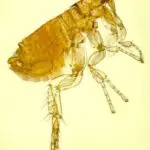How Do Fleas Get Bigger?
The life cycle of a flea is quite similar for all species, repeating itself with some variations. The larvae are only a few millimeters long and half a millimeter wide before pupating and taking on their characteristic shape. Fleas spend most of their time on their host animal. They can live for several weeks or months.
Fleas live on mammals and birds, and their size varies according to the host. They have a protective chitin exoskeleton that makes them difficult to grow larger than they already are. The problem is that these insects often bite humans, and a small number of flea bites on your legs is one of the telltale signs of an infestation.
Fleas are wingless insects that grow to about an eighth of an inch long. They are reddish-brown in color and have large back legs. Adult fleas can jump about a foot and a half and can survive a full day by feeding on blood. They also have a sensilium on their bodies that detects temperature, movement, and vibration. These properties help them locate their hosts.
Flea life cycle is short in comparison to other insects. They develop in three stages: the egg, the larva, and the pupa. The life cycle of a flea may take as little as four to eight weeks. The larvae then spin silk cocoons that are then attached to debris. They remain in their cocoons for up to a year before emerging as an adult flea.








